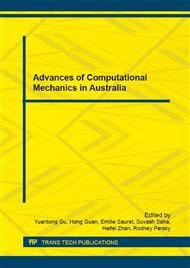[1]
B. Persson, O. Albohr, U. Tartaglino, A. Volokitin, E. Tosatti, On the nature of surface roughness with application to contact mechanics, sealing, rubber friction and adhesion, Journal of Physics: Condensed Matter, 17 (2005) R1.
DOI: 10.1088/0953-8984/17/1/r01
Google Scholar
[2]
V.L. Popov, Contact mechanics and friction, Springer Science & Business Media, Berlin, (2010).
Google Scholar
[3]
J. Greenwood, J. Williamson, Contact of nominally flat surfaces, Proceedings of the Royal Society of London. Series A. Mathematical and Physical Sciences, 295 (1966) 300-319.
DOI: 10.1098/rspa.1966.0242
Google Scholar
[4]
A. Bush, R. Gibson, T. Thomas, The elastic contact of a rough surface, Wear, 35 (1975) 87-111.
DOI: 10.1016/0043-1648(75)90145-3
Google Scholar
[5]
W. Chang, I. Etsion, D.B. Bogy, An elastic-plastic model for the contact of rough surfaces, Journal of tribology, 109 (1987) 257-263.
DOI: 10.1115/1.3261348
Google Scholar
[6]
W. Yan, K. Komvopoulos, Contact analysis of elastic-plastic fractal surfaces, Journal of Applied Physics, 84 (1998) 3617-3624.
DOI: 10.1063/1.368536
Google Scholar
[7]
S. Jiang, Y. Zheng, H. Zhu, A contact stiffness model of machined plane joint based on fractal theory, Journal of Tribology, 132 (2010) 011401.
DOI: 10.1115/1.4000305
Google Scholar
[8]
R. Pohrt, V.L. Popov, Normal contact stiffness of elastic solids with fractal rough surfaces, Physical Review Letters, 108 (2012) 104301.
DOI: 10.1103/physrevlett.108.104301
Google Scholar
[9]
R. Buzio, C. Boragno, F. Biscarini, F.B. De Mongeot, U. Valbusa, The contact mechanics of fractal surfaces, Nature Materials, 2 (2003) 233-236.
DOI: 10.1038/nmat855
Google Scholar
[10]
B. Lorenz, B. Persson, Interfacial separation between elastic solids with randomly rough surfaces: comparison of experiment with theory, Journal of Physics: Condensed Matter, 21 (2009) 015003.
DOI: 10.1088/0953-8984/21/1/015003
Google Scholar
[11]
D. Mulvihill, H. Brunskill, M. Kartal, R. Dwyer-Joyce, D. Nowell, A comparison of contact stiffness measurements obtained by the digital image correlation and ultrasound techniques, Experimental Mechanics, 53 (2013) 1245-1263.
DOI: 10.1007/s11340-013-9718-5
Google Scholar
[12]
G. Carbone, F. Bottiglione, Asperity contact theories: Do they predict linearity between contact area and load?, Journal of the Mechanics and Physics of Solids, 56 (2008) 2555-2572.
DOI: 10.1016/j.jmps.2008.03.011
Google Scholar
[13]
C. Zhai, D. Hanaor, G. Proust, Y. Gan, Stress-Dependent Electrical Contact Resistance at Fractal Rough Surfaces, Journal of Engineering Mechanics, (2015) B4015001.
DOI: 10.1061/(asce)em.1943-7889.0000967
Google Scholar
[14]
H. Xie, J. -a. Wang, Direct fractal measurement of fracture surfaces, International Journal of Solids and Structures, 36 (1999) 3073-3084.
DOI: 10.1016/s0020-7683(98)00141-3
Google Scholar
[15]
P. Liu, H. Zhao, K. Huang, Q. Chen, Research on normal contact stiffness of rough surface considering friction based on fractal theory, Applied Surface Science, 349 (2015) 43-48.
DOI: 10.1016/j.apsusc.2015.04.174
Google Scholar
[16]
B.B. Mandelbrot, The fractal geometry of nature, Macmillan, (1983).
Google Scholar
[17]
D.A. Hanaor, Y. Gan, I. Einav, Effects of surface structure deformation on static friction at fractal interfaces, Geotechnique Letters, 3 (2013) 52-58.
DOI: 10.1680/geolett.13.016
Google Scholar
[18]
L. Kogut, R.L. Jackson, A comparison of contact modeling utilizing statistical and fractal approaches, Journal of tribology, 128 (2006) 213-217.
DOI: 10.1115/1.2114949
Google Scholar
[19]
G. Pharr, W. Oliver, F. Brotzen, On the generality of the relationship among contact stiffness, contact area, and elastic modulus during indentation, Journal of materials research, 7 (1992) 613-617.
DOI: 10.1557/jmr.1992.0613
Google Scholar
[20]
W.C. Oliver, G.M. Pharr, Measurement of hardness and elastic modulus by instrumented indentation: Advances in understanding and refinements to methodology, Journal of Materials Research, 19 (2004) 3-20.
DOI: 10.1557/jmr.2004.19.1.3
Google Scholar


